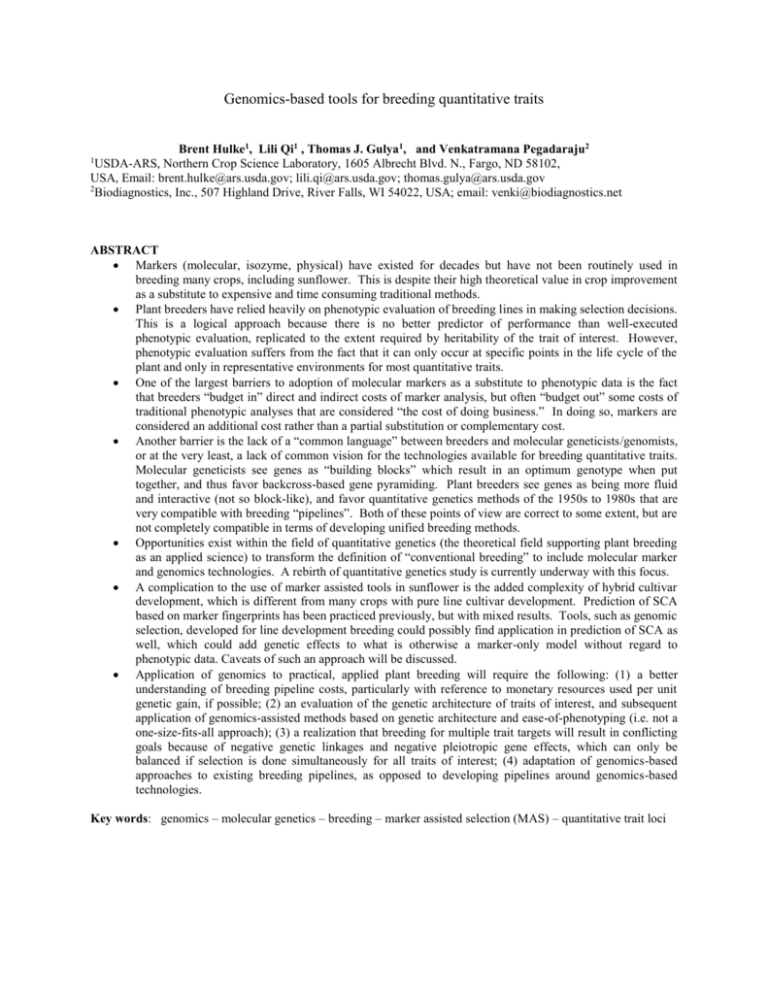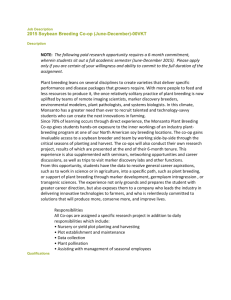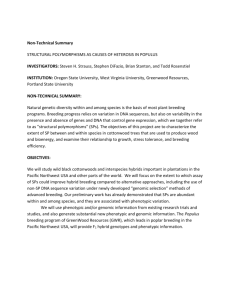Genomics-based tools for breeding quantitative traits Brent Hulke1
advertisement

Genomics-based tools for breeding quantitative traits Brent Hulke1, Lili Qi1 , Thomas J. Gulya1, and Venkatramana Pegadaraju2 USDA-ARS, Northern Crop Science Laboratory, 1605 Albrecht Blvd. N., Fargo, ND 58102, USA, Email: brent.hulke@ars.usda.gov; lili.qi@ars.usda.gov; thomas.gulya@ars.usda.gov 2 Biodiagnostics, Inc., 507 Highland Drive, River Falls, WI 54022, USA; email: venki@biodiagnostics.net 1 ABSTRACT Markers (molecular, isozyme, physical) have existed for decades but have not been routinely used in breeding many crops, including sunflower. This is despite their high theoretical value in crop improvement as a substitute to expensive and time consuming traditional methods. Plant breeders have relied heavily on phenotypic evaluation of breeding lines in making selection decisions. This is a logical approach because there is no better predictor of performance than well-executed phenotypic evaluation, replicated to the extent required by heritability of the trait of interest. However, phenotypic evaluation suffers from the fact that it can only occur at specific points in the life cycle of the plant and only in representative environments for most quantitative traits. One of the largest barriers to adoption of molecular markers as a substitute to phenotypic data is the fact that breeders “budget in” direct and indirect costs of marker analysis, but often “budget out” some costs of traditional phenotypic analyses that are considered “the cost of doing business.” In doing so, markers are considered an additional cost rather than a partial substitution or complementary cost. Another barrier is the lack of a “common language” between breeders and molecular geneticists/genomists, or at the very least, a lack of common vision for the technologies available for breeding quantitative traits. Molecular geneticists see genes as “building blocks” which result in an optimum genotype when put together, and thus favor backcross-based gene pyramiding. Plant breeders see genes as being more fluid and interactive (not so block-like), and favor quantitative genetics methods of the 1950s to 1980s that are very compatible with breeding “pipelines”. Both of these points of view are correct to some extent, but are not completely compatible in terms of developing unified breeding methods. Opportunities exist within the field of quantitative genetics (the theoretical field supporting plant breeding as an applied science) to transform the definition of “conventional breeding” to include molecular marker and genomics technologies. A rebirth of quantitative genetics study is currently underway with this focus. A complication to the use of marker assisted tools in sunflower is the added complexity of hybrid cultivar development, which is different from many crops with pure line cultivar development. Prediction of SCA based on marker fingerprints has been practiced previously, but with mixed results. Tools, such as genomic selection, developed for line development breeding could possibly find application in prediction of SCA as well, which could add genetic effects to what is otherwise a marker-only model without regard to phenotypic data. Caveats of such an approach will be discussed. Application of genomics to practical, applied plant breeding will require the following: (1) a better understanding of breeding pipeline costs, particularly with reference to monetary resources used per unit genetic gain, if possible; (2) an evaluation of the genetic architecture of traits of interest, and subsequent application of genomics-assisted methods based on genetic architecture and ease-of-phenotyping (i.e. not a one-size-fits-all approach); (3) a realization that breeding for multiple trait targets will result in conflicting goals because of negative genetic linkages and negative pleiotropic gene effects, which can only be balanced if selection is done simultaneously for all traits of interest; (4) adaptation of genomics-based approaches to existing breeding pipelines, as opposed to developing pipelines around genomics-based technologies. Key words: genomics – molecular genetics – breeding – marker assisted selection (MAS) – quantitative trait loci








